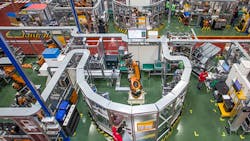Brake system specialist Brembo S.p.A. started up a new aluminum foundry near Monterrey, Mexico, a project estimated at $39 million when it was launched in 2014. While the new plant is designed to produce brake calipers for automobiles, at the event staged to mark the opening company president Alberto Bombassei also announced that Brembo will start building a second foundry at the site to produce cast iron discs for brake rotors.
The Italian group produces brake systems for cars, motorcycles, and light trucks. The new iron foundry will be Brembo’s fifth disc brake operation, following on the recent start-up of an iron foundry and brake assembly complex in Homer, MI, and previous projects in Poland, China, and Italy.
The 377,000-sq.ft. aluminum foundry at Escobedo, Nuevo Leon, offers melting capacity of 14,000 metric tons/year, casting, and finish machining capability for 2 million aluminum caliper units per year at full capacity. Employment at the aluminum complex will total about 500, according to the company’s statement.
The new iron foundry is estimated as a $93-million project for Brembo. It indicated construction would begin adjacent to the aluminum foundry “in a few weeks,” for operation to begin late in 2017.
The 269,000- sq.ft. plant will have a melting capacity of approximately 100,000 metric tons per year, and employ approximately 200 people.
The output of both plants will be directed at North American, European, and Asian automakers and automotive suppliers operating in Mexico. Brembo has previously identified the North American automotive market as the most important region for its growth strategy.
About the Author
Robert Brooks
Content Director
Robert Brooks has been a business-to-business reporter, writer, editor, and columnist for more than 20 years, specializing in the primary metal and basic manufacturing industries. His work has covered a wide range of topics, including process technology, resource development, material selection, product design, workforce development, and industrial market strategies, among others.
